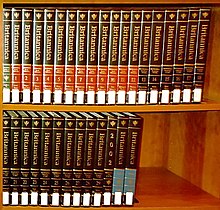Reference work
You can help expand this article with text translated from the corresponding article in German. (May 2012) Click [show] for important translation instructions.
|



A reference work is a book or periodical (or its electronic equivalent) to which one can refer for information. The information is intended to be found quickly when needed. Reference works are usually referred to for particular pieces of information, rather than read beginning to end. The writing style used in these works is informative; the authors avoid use of the first person, and emphasize facts. Many reference works are compiled by a team of contributors whose work is coordinated by one or more editors rather than by an individual author. Indices are commonly provided in many types of reference work. Updated editions are usually published as needed, in some cases annually (e.g. Whitaker's Almanack, Who's Who). Reference works include dictionaries, thesauruses, encyclopedias, almanacs, bibliographies, and catalogs (e.g. catalogs of libraries, museums or the works of individual artists).[1] Many reference works are available in electronic form and can be obtained as application software, CD-ROMs, DVDs, or online through the Internet.
A reference work is useful to its users if they attribute some degree of trust.
Reference book
In comparison, a reference book or reference-only book in a library is one that may only be used in the library and may not be borrowed from the library. Many such books are reference works (in the first sense), which are, usually, used briefly or photocopied from, and therefore, do not need to be borrowed. Keeping reference books in the library assures that they will always be available for use on demand. Some reference-only books are too valuable to permit borrowers to take them out. Reference-only items may be shelved in a reference collection located separately from circulating items. Some libraries consist entirely, or to a large extent, of books which may not be borrowed.
Electronic resources
An electronic resource is a piece of information that is stored electronically, which is usually found on a computer, including information that is available on the internet.[2] Libraries offer numerous types of electronic resources, such as subject research guides, indices, electronic books and texts, electronic journals, library catalogs, reference sources, statistical sources, sound recordings, and image databases.[3]
References
- ^ The University of Santo Tomas Miguel de Benavides Library. "The Reference Materials". Archived from the original on 7 May 2012. Retrieved 3 May 2012.
{{cite web}}: Unknown parameter|deadurl=ignored (|url-status=suggested) (help) - ^ AllWords.com. "Electronic Resources".
- ^ The University of Chicago Library. "Types of Electronic Resources". Retrieved 3 May 2012.
Further reading
- General
- American Reference Books Annual: ARBA. Littleton, Col.: Libraries Unlimited, 1970-
- Bergenholtz, H., Nielsen, S., Tarp, S. (eds.): Lexicography at a Crossroads: Dictionaries and Encyclopedias Today, Lexicographical Tools Tomorrow. Peter Lang 2009. ISBN 978-3-03911-799-4
- Higgens, G., ed. (1980) Printed Reference Material (Handbooks on Library Practice.) London: Library Association
- Katz, W. A. (1978) Introduction to Reference Work; 3rd ed. 2 vols. New York: McGraw-Hill
- Nielsen, Sandro "The Effect of Lexicographical Information Costs on Dictionary Making and Use". In: Lexikos 18 (2008), 170-189.
- Guides to reference works
Sheehy's Guide is less international in its scope than Walford: "It seems that Walford is a somewhat better balanced work than Winchell, and is certainly much more comprehensive"--American Reference Books Annual, quoted in Walford, A. J. (1981) Walford's Concise Guide to Reference Material. London: Library Association ISBN 0-85365-882-X; p. 19.
- Heeks, P., comp. (1968) Books of Reference for School Libraries: an annotated list; 2nd ed. London: Library Association (a basic list of 301 annotated entries useful for any small library)
- Malclès, L.-N. (1950) Les sources du travail bibligraphique. 3 vols. in 4. Geneva: Droz, 1950-58 (reissued by Minard, Paris, & French & European Publications, New York, 1966)
- Sheehy, E. P. et al., comps. (1976) Guide to Reference Books; 9th ed. Chicago: American Library Association; Supplement, 1980 (began with a guide compiled by A. B. Kroeger, 1917; 3rd-6th eds. by I. G. Mudge; 7th & 8th by C. M. Winchell)
- Totok, W. & Weitzel, R. (1972) Handbuch der bibliographischen Nachschlagewerke; 4. Aufl., hrg. von W. Totok, K.-H. Weimann, R. Weitzel. Frankfurt am Main: Klostermann (1st ed. 1954)
- Day, Alan (editor) (1998). Walford's Guide to Reference Material. London: Library Association Publishing.
{{cite book}}:|first=has generic name (help);|format=requires|url=(help) - Walford, A. J. (1980–82). Walford's Guide to Reference Material (4th ed.). London: Library Association.
